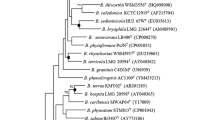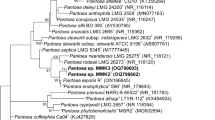Abstract
A Gram-positive bacterium, designated M-GX18T, was isolated from the rhizosphere soil of mango (Guangxi Province, China). The isolate produced nematicidal volatile compounds with activities against the root-knot nematode Meloidogyne incognita. The organism was motile, catalase- and oxidase-positive, spore-forming and rod shaped. The predominant menaquinone was MK-7 and the major cellular fatty acid profiles were iso-C15:0, anteiso-C15:0 and iso-C16:0. The DNA G+C content was 38.9%. A phylogenetic analysis based on 16S rRNA gene sequences showed that this organism represented a new species of the genus Lysinibacillus. Strain M-GX18T exhibited high 16S rRNA gene sequence similarity with its closest neighbors Lysinibacillus sphaericus (98.5%), Lysinibacillus fusiformis (98.1%) and Lysinibacillus xylanilyticus (98.6%). The physiological, biochemical and chemotaxonomic data, including DNA–DNA hybridization relatedness data, indicate that strain M-GX18T can be distinguished from all the related species of the genus Lysinibacillus. Therefore, on the basis of the polyphasic taxonomic data presented, a new species of the genus Lysinibacillus, Lysinibacillus mangiferahumi, with the type strain M-GX18T (=DSM 24076T = CCTCC AB 2010389T) is proposed.

Similar content being viewed by others
References
Ahmed I, Yokota A, Yamazoe A, Fujiwara T (2007) Proposal of Lysinibacillus boronitolerans gen. nov., sp. nov., and transfer of Bacillus fusiformis to Lysinibacillus fusiformis comb. nov. and Bacillus sphaericus to Lysinibacillus sphaericus comb. nov. Int J Syst Evol Microbiol 57:1117–1125
Collins MD, Jones D (1980) Lipids in the classification and identification of coryneform bacteria containing peptidoglycan based on 2,4-diaminobutyric acid. J Appl Bacteriol 48:459–470
Collins MD, Pirouz T, Goodfellow M, Minnikin DE (1977) Distribution of menaquinones in actinomycetes and corynebacteria. J Gen Microbiol 100:221–230
Coorevits A, Dinsdale AE, Heyrman J, Schumann P, Landschoot AV, Logan NA, Vos PD (2011) Lysinibacillus macroides sp. nov., nom. rev. Int J Syst Evol Microbiol. doi:10.1099/ijs.0.027995-0
Díaz A, Vàzquez L, Ventura F, Galceran MT (2004) Estimation of measurement uncertainty for the determination of nonylphenol in water using solid-phase extraction and solid-phase microextraction procedures. Anal Chim Acta 506:71–80
Ezaki T, Hashimoto Y, Yabuuchi E (1989) Fluorometric deoxyribonucleic acid–deoxyribonucleic acid hybridization in microdilution wells as an alternative to membrane filter hybridization in which radioisotopes are used to determine genetic relatedness among bacterial strains. Int J Syst Bacteriol 39:224–229
Felsenstein J (1981) Evolutionary trees from DNA sequences: a maximum likelihood approach. J Mol Evol 17:368–376
Felsenstein J (1985) Confidence limits on phylogenies: an approach using the bootstrap. Evolution 39:783–789
Fitch WM (1971) Toward defining the course of evolution: minimum change for a specific tree topology. Syst Zool 20:406–416
Gregersen T (1978) Rapid method for distinction of Gram-negative from Gram-positive bacteria. Eur J Appl Microbiol Biotechnol 5:123–127
Groth I, Schumann P, Rainey FA, Martin K, Schuetze B, Augsten K (1997) Demetria terragena gen. nov., sp. nov., a new genus of actinomycetes isolated from compost soil. Int J Syst Bacteriol 47:1129–1133
Gu YQ, Mo MH, Zhou JP, Zou CS, Zhang KQ (2007) Evaluation and identification of potential organic nematicidal volatiles from soil bacteria. Soil Biol Biochem 39:2567–2575
Guindon S, Gascuel O (2003) PhyML––A simple, fast, and accurate algorithm to estimate large phylogenies by maximum likelihood. Syst Biol 52:696–704
He L, Li W, Huang Y, Wang LM, Liu ZH, Lanoot BJ, Vancanneyt M, Swings J (2005) Streptomyces jietaisiensis sp. nov., isolated from soil in northern China. Int J Syst Evol Microbiol 55:1939–1944
Huang Y, Xu CK, Ma L, Zhang KQ, Duan CQ, Mo MH (2010) Characterisation of volatiles produced from Bacillus megaterium YFM3.25 and their nematicidal activity against Meloidogyne incognita. Eur J Plant Pathol 126:417–422
Lee CS, Jung Y-T, Park S, Oh T-K, Yoon J-H (2010) Lysinibacillus xylanilyticus sp. nov., a xylan-degrading bacterium isolated from forest humus. Int J Syst Evol Microbiol 60:281–286
Li W-J, Xu P, Schumann P, Zhang Y-Q, Pukall R, Xu L-H, Stackebrandt E, Jiang C-L (2007) Georgenia ruanii sp. nov., a novel actinobacterium isolated from forest soil in Yunnan (China) and emended description of the genus Georgenia. Int J Syst Evol Microbiol 57:1424–1428
Mesbah M, Premachandran U, Whitman WB (1989) Precise measurement of the G + C content of deoxyribonucleic acid by high-performance liquid chromatography. Int J Syst Bacteriol 39:159–167
Minnikin DE, Collins MD, Goodfellow M (1979) Fatty acid and polar lipid composition in the classification of Cellulomonas, Oerskovia and related taxa. J Appl Bacteriol 47:87–95
Oka Y, Shuker S, Tkachi N (2009) Nematicidal efficacy of MCW-2, a new nematicide of the fluoroalkenyl group, against the root-knot nematode Myloidogyne javanica. Pest Manag Sci 65(10):1082–1089
Saitou N, Nei M (1987) The neighbor-joining method: a new method for reconstructing phylogenetic tree. Mol Biol Evol 4:406–425
Schleifer KH, Kandler O (1972) Peptidoglycan types of bacterial cell walls and their taxonomic implications. Bacteriol Rev 36:407–477
Smibert RM, Krieg NR (1994) Phenotypic characterization. In: Gerhardt P, Murray RGE, Wood WA, Krieg NR (eds) Methods for General and Molecular Bacteriology. American Society for Microbiology, Washington, DC, pp 607–654
Tamura K, Dudley J, Nei M, Kumar S (2007) MEGA4: Molecular Evolutionary Genetics Analysis (MEGA) Software Version 4.0. Mol Biol Evol 24:1596–1599
Tang S-K, Wang Y, Chen Y, Lou K, Cao L-L, Xu L-H, Li W-J (2009) Zhihengliuella alba sp. nov., and emended description of the genus Zhihengliuella. Int J Syst Evol Microbiol 59:2025–2031
Tang S-K, Wang Y, Guan T-W, Lee J-C, Kim C-J, Li W-J (2010) Amycolatopsis halophila sp. nov., a halophilic actinomycete isolated from a salt lake. Int J Syst Evol Microbiol 60:1073–1078
Thompson JD, Gibson TJ, Plewniak F, Jeanmougin F, Higgins DG (1997) The Clustal X windows interface: flexible strategies for multiple sequence alignment aided by quality analysis tools. Nucleic Acids Res 25:4876–4882
Wayne LG, Brenner DJ, Colwell RR, Grimont PAD, Kandler O, Krichevsky MI, Moore LH, Moore WEC, Murray RGE, Stackebrandt E, Starr MP, Trüper HG (1987) International Committee on Systematic Bacteriology. Report of the Ad Hoc committee on reconciliation of approaches to bacterial systematics. Int J Syst Bacteriol 37:463–464
Xu CK, Mo MH, Zhang LM, Zhang KQ (2004) Soil volatile fungistasis and volatile fungistatic compounds. Soil Biol Biochem 36:1997–2004
Acknowledgments
This work was funded jointly by “National Key Sciences and Technology Program for Water Solutions” (2012ZX07102-003), NSFC (31160376, 30970100), Department of Science and Technology of Yunnan Province (2011FA002, 11N010905) and the Special Fund of Green Agricultural Biotechnology Products of National Development and Reform Commission.
Author information
Authors and Affiliations
Corresponding authors
Additional information
Authors Ling-Ling Yang and Ying Huang have contributed equally to this work.
Electronic supplementary material
Below is the link to the electronic supplementary material.
Rights and permissions
About this article
Cite this article
Yang, LL., Huang, Y., Liu, J. et al. Lysinibacillus mangiferahumi sp. nov., a new bacterium producing nematicidal volatiles. Antonie van Leeuwenhoek 102, 53–59 (2012). https://doi.org/10.1007/s10482-012-9712-4
Received:
Accepted:
Published:
Issue Date:
DOI: https://doi.org/10.1007/s10482-012-9712-4




